RAY
SCOTT OUTDOORS™
Presents
Bob Cobb
Where-To-Go Report
The Bass Boys Tackle
Historic Columbia River
From the
Tri-Cities area, the last remaining free-flowing waters offer
smallmouth anglers a trek
off the Lewis and Clark Trail…
COLUMBIA RIVER, Washington – For
such big country the sign appeared undersize. Staked
about every 100 yards along the shoreline, the 12 x 12 yellow marker warned visitors away: “POSTED:
United States Department of Energy.”
Approximately
45 minutes north from the Tri-Cities of Richland, Kennewick and Pasco, the Columbia River
winds along the DOE’s Handford site boundary.
"See
those big cranes over there,” motioned Bruce Ratchford, a local construction company
owner and bass fisherman. “That’s
where the DOE buries atomic submarine reactors. Sometimes
we see the units being barged up the river to the burial grounds. Don’t worry.
They tell us it’s safe to fish here.”
Gene
Batey Jr., one of the Bass Anglers Sportsman Society’s top Western Division
Federation anglers, had told Ray Scott he’d find fishing for Columbia River
smallmouth to be “explosive action,” but nothing was mentioned about atomic
reaction or nuclear active waste.
During
the WW II atomic bomb building venture, this was a classified area. It still is…for smallmouth bass anglers. The shallow backwaters off the main channel harbor
a secret shared by members of the Tri-Cities Bassmasters.
Batey
and his tournament partner, Ron Mace, boated a five bass limit of bronzebacks, hitting the
scales at 24-pounds, 10-ounces to best a 27-boat tournament field the past weekend. With the live-bass bonus, they scored 25-10.
But,
without the “bonus,” the creel averaged almost five-pounds per smallmouth. Anywhere you travel that’s an impressive
average size bag. “It was no
fluke,” claims Batey. “We get on
the big smallmouth, every May, when they move back into these cuts. Water temperature’s inching into the low 50s
and we should start seeing more fish back here.”
As a
sidebar to the afore mentioned tournament out of Richland’s Columbia Point Park, the
proof of braggin’ bronzebacks showed up in the weigh-in creel: a 7-pound smallmouth checked in by a 14-year old
angler.
“There’s a nice fish right
there,” pointed out Bruce Ratchford as he tried to maneuver his 21-foot Triton rig
over a shallow shoal against the swift flowing current.
The big brown fish flicked its
tail and disappeared into the swirling water. Elsewhere
a basser would refer to where the fish was holding as an “eddy” spot, but here
in the Pacific Northwest fishermen refer to “looking for the soft water.”
The Columbia River, today, is a
far cry from the wilderness tributary that the Lewis and Clark Expedition first
encountered on the exploration of the American West in 1804-06. Navigating down the Columbia, the explorers in
November 1805 reached the “great Pacific Ocean” which they had been so long
anxious to see.
The epic feat fired the
imagination of the American people. The more
than 8,000 miles (roundtrip) covered a period of two years, four months and 10 days. Its findings contributed vital new knowledge
concerning the vast western lands, its resources and its native inhabitants.
Today, the Lewis and Clark
Trail is marked by frequent dams, power generators and navigation locks. But, there are yet “wild, free flowing
sections.”
“That’s probably what
makes this such a great area for smallmouth fishing,” pointed out Ratchford. “The area below the Priest Rapids Dam (near
Desert Aire, WA) to Lake Wallula, downstream below the Tri-Cities, is the last
free-flowing area left on the Columbia.”
The status of the area’s
smallmouth fishing is gaining in the outside bassin’ world. The Bassmaster Tournament Trail’s Western
circuit fished here last season, and Bruce Ratchford and Gene Batey are pushing the local
tourist department to bring the B.A.S.S. tour back in the fall of 2000. Matter of fact, Ratchford is so supportive he
plunked down $10,000 to help fund the tournament fee of $25,000.
That’s quite a public
service gesture in a state where the fishery department, generally, views the “black
bass as a trash fish.”
But the state’s total
allegiance to the coldwater species – salmon, trout and steelheads – is
changing. There’s work to be done,
however.
The Washing Department of Fish
and Game, for instance, stocked 118 million salmon, 14 million trout and kokanee and 7
million steelhead “for harvest.” At
the same time, the state hatchery crew released 510,000 warmwater fish species, including
2,200 largemouth bass. That’s right only
two thousand, two hundred bass.
But, to the largemouth’s credit,
the bass is more than a put-and-take fishery. “We’ve
got some outstanding bass fishing in the state. Banks
Lake (below the Grand Coulee Dam) is coming on like Gangbusters and is loaded with quality
fish,” said Jim Owens of Renton, Washington, the former president of the B.A.S.S.
Washington state Federation.
“We’re making strides
with the state fishery biologists,” believes Owens, “and we’re gaining
support with more bass clubs and fishermen. They’re
using bass slot limits to manage the warmwater fisheries.
The daily limit is five bass of less than 12 inches or greater than 17
inches in length, with no more than one bass over 17 inches.”
Jim Owens is still active in
the bass fishing arena, but more of his energies now are centered on the C.A.S.T. for Kids
Foundation as executive director.
The acronym stands for
“Catch A Special Thrill,” and with fishing outings scheduled in 30 states,
already, this year the program is attracting national attention.
“The thrill comes with
seeing the smile on the face of a disabled or disadvantaged child catch their first
fish,” explains Jim Owens, who quit his fulltime job as a college bookstore manager
to undertake the task.
The C.A.S.T. for Kids
Foundation partners with national, regional and local agencies, as well as, sponsors
donating equipment and tackle and volunteers to organize and support the events.
On September 23-24, 2000, the
First Annual C.A.S.T. for Kids Charity Tournament will be held on the Columbia River out
of the Tri-Cities. Proceeds will support the
organization’s fishing programs for youths. Entry
fee is $250 per two-man team and will be limited to the first 250 entries.
“We’ve got the
support of Triton Boats and Earl Bentz, who has contributed a Triton 186-DC rig as the
grand prize. With a full field we’ll
payout an additional $19,000, making this one of the largest events of its type in the
Pacific Northwest,” opines Owens.
For information on the C.A.S.T.
for Kids Foundation and Charity Tournament, call Jim Owens at (425) 251-3214 or e-mail him
at jowens@castforkids.org.
However, today the
“Bassin’ Gods” were not the least bit cooperative. The wind had its way. Whitecaps, with four-footers turning the Columbia
River into a butt-bouncing boat ride.
“With Ray Scott here, they
must think there’s going to be a bass tournament,” smiled Gene Batey. “Ray shows up and the weather goes into the
toilet.”
There was no escape from Mother
Nature’s dust blower. Tumbleweeds rolled
along the shoreline kicked up by the over 50 miles per hour winds.
“You can’t fish a
soft plastic with all this belly in your line,” noted Bruce Ratchford, who hollered
at the trio in the other boat, “Let’s try another spot.”
Picture a smallmouth structure? Something like a rockpile, steep point or below a
fast-moving ripple. Right? Not here off the Columbia.
The two boats followed a
twisting, shallow-water path blasting into a backwater slough and forgotten lake. The area looked more like largemouth habitat, but
the first strike produced a feisty smallmouth for Ray Scott fishing a Slider worm along a
weedy, shallow shoreline below the run-off into the backwaters.
An advocate of light-tackle,
Scott played the smallmouth on four-pound test line and a prototype 7-foot spinning rod by
D & E Rods of Battle Ground, Washington. The
special stick and action – designed by Scott – and built by Vern Dollar’s
shop won the battle.
Trying to work a grub with an
open leadhead hook over the grassy bottom proved fruitless.
But, Bruce Ratchford had the answer. The
four-inch Zipper grub rigged Texas style with the hook point buried and a pegged sinker
hit next to the weedy shoreline.
“You’ve got to cast
right at the weeds, let it fall and feel for the hit.
It’s tough in this wind,” explained Bruce.
For a big guy that runs a
construction company, Ratchford has the touch of a finesse fisherman. “Yep, there’s one,” he proclaimed.
The smallmouth ripped off the
shoreline and rocketed into the air – a leaping lunker in the thin water. Bruce hollered, “Get the net.” Then, realized this was a photo opportunity and
he’d have to lip-land his catch.
Bass and angler performed for
the shutter snapper. Photo proof of the
Columbia River’s “explosive action.” And,
with such gale-force winds it would have been just as easy to bomb out.
The trek back down the waterway
with the current ripping against the strong wind blasts had its rough moments. Bruce’s big Triton ride with 225 horses made
a difference.
Think what you would encounter
trying to paddle a dugout canoe – as Meriwether Lewis, William Clark and the
“Corps of Discovery” must have – to battle the powerful currents of these
raging waters.
Such are the thoughts while
fishing the historic Columbia.
For current conditions or tips
on fishing the Columbia River out of the Tri-Cities area, contact: Gene Batey, Jr., 6105 West Park, Pasco, WA 99301; Phone (509) 545-2609 or Bruce Ratchford,
5501 South Ely, Kennewick, WA 99336, Ph (509)
586-6333.
Historic
Columbia River
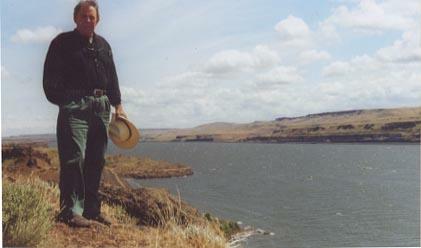
Overlooking the Columbia River basin, Ray Scott views the area
where Lewis and Clark traveled to explore the American West in 1804 – 1806.
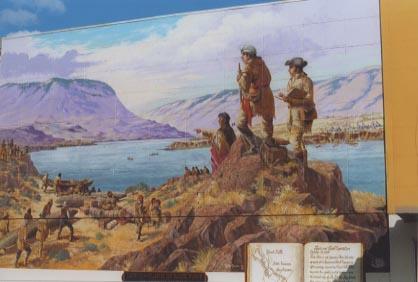
Lewis and Clark mural by Robert Thomas in the downtown historic
district of The Dalles, Oregon. The
“Great Falls” and currents of the “Long and Short Narrows” (all now
inundated) were formidable navigational barriers for the explorers. Dugout canoes are being carved out in the
painting.
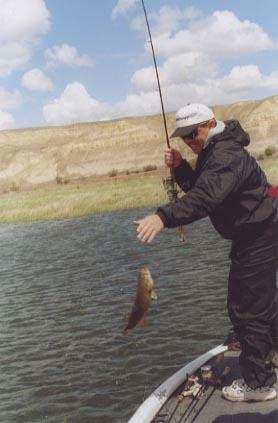
Small, soft-plastic grubs and tube baits are favorites for
smallmouth bass by local experts, like Gene Batey, Jr. of Pasco, Washington.
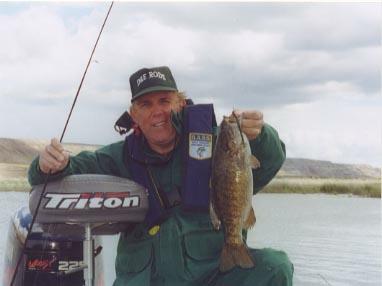
Ray Scott’s first smallmouth from the famed Columbia River
came on a Charlie Brewer’s Slider worm. A
light-tackle advocate, Ray fished four-pound line on a new prototype-spinning rod built by
Vern Dollar of D & E Rods.
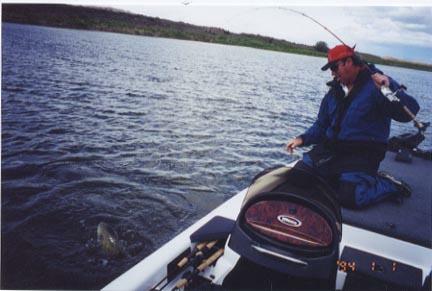
Mid-May is a prime time for braggin’ bronzebacks on the
Columbia River as the pre-spawn and spawning period arrives. Bruce Ratchford of Kennewick, Washington tries to
tame a Wild West smallmouth.
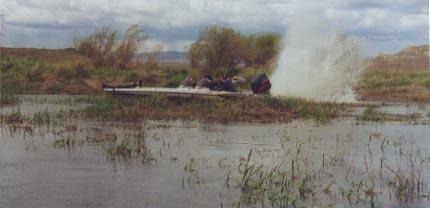
Weedy, backwater haunts off the main Columbia River channel are
reached by blasting over the shallow bars, but you don’t expect to find smallmouth
bass in the grassy habitat. That’s where
local know-how makes the difference.
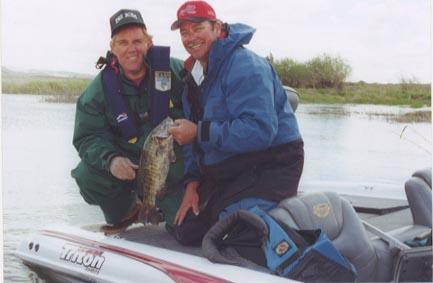
Tri-Cities Bassmaster Bruce Ratchford shows B.A.S.S. founder
Ray Scott what bassin’ on the Columbia River is all about. Four-pound smallmouth are the norm here.
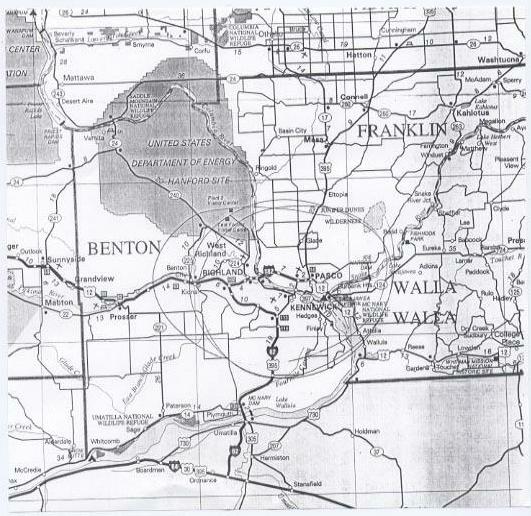
|

![]()
